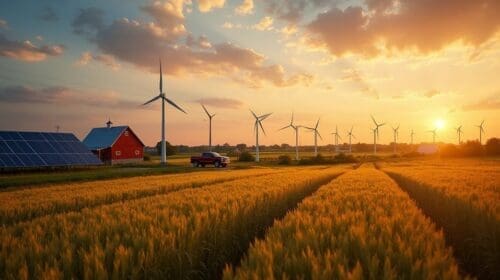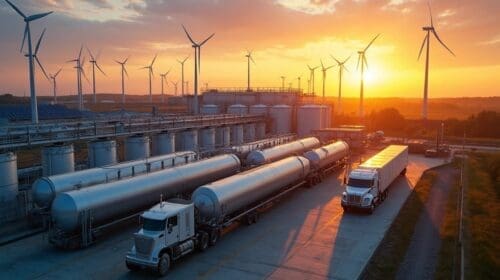Wind energy production in the United States reached new heights in 2024, generating enough electricity to power millions of American homes. The Top 5 Wind Producing States in the US continue to break records and lead the nation’s transition toward renewable energy. These states demonstrate how wind power has become a reliable and cost-effective energy source for American communities.
Texas, Iowa, Oklahoma, Kansas, and California stand at the forefront of American wind energy production, each contributing significantly to the nation’s renewable energy capacity. These states have achieved their leadership positions through strategic investments, favorable geographic conditions, and strong policy support for renewable energy development. Our analysis examines their current wind energy capacity, notable projects, and the factors behind their success.
Texas: The Undisputed Wind Energy Leader
Image Source: Reuters
Leading the nation’s renewable energy transformation, Texas has established itself as an unmatched powerhouse in wind energy production. With over 40,500 megawatts of installed capacity and more than 16,000 wind turbines, the Lone Star State’s commitment to wind power has set unprecedented benchmarks in renewable energy generation.
Texas Wind Energy Capacity
Texas dominates the national wind energy landscape, contributing 28% of the country’s total wind power production. The state’s wind energy infrastructure has grown remarkably, with wind power now accounting for 23.48% of Texas’s electricity generation mix, second only to natural gas. In 2023, Texas generated an impressive 119,836 GWh of wind power, adding 1,309 MW of new capacity – a 3% annual increase that reinforces its leadership position.
Notable Wind Farms in Texas
The state hosts several world-class wind energy facilities, with these standing out as the most significant:
| Wind Farm | Capacity (MW) | Notable Features |
|---|---|---|
| Los Vientos | 910 | 400+ turbines powers 120,000 homes |
| Roscoe | 781.5 | 627 turbines across 100,000 acres |
| Horse Hollow | 735 | 421 turbines spanning two counties |
Factors Contributing to Texas’ Wind Energy Success
The state’s remarkable achievement in wind energy can be attributed to several key factors:
- Geographic Advantage: Texas benefits from its position in a natural wind belt, particularly in West Texas, where consistent wind patterns provide optimal conditions for energy generation
- Infrastructure Investment: The state’s extensive power infrastructure, including nearly 500 miles of transmission lines and the Competitive Renewable Energy Zone (CREZ) initiative, has enabled efficient power distribution
- Economic Benefits: Wind energy has created over 24,000 local jobs while providing farmers with additional revenue through land leases, typically generating $3,000-$5,000 per turbine annually
- Policy Support: The state’s Renewable Portfolio Standard and favorable tax ecosystem have encouraged substantial investment in wind energy development
The wind power industry has transformed Texas’s energy landscape while generating significant economic benefits. The state’s wind farms not only power millions of homes but also contribute substantially to rural development and environmental sustainability. If Texas were a country, it would rank as the world’s fifth-largest wind power producer, surpassing most nations in installed wind capacity.
Iowa: The Hawkeye State’s Wind Power Dominance

Image Source: Iowa Environmental Council
Setting unprecedented benchmarks in renewable energy adoption, Iowa has transformed its energy landscape with wind power generating an impressive 62% of its electricity – the highest percentage of any state in America. This remarkable achievement positions Iowa as a cornerstone in the nation’s renewable energy future.
Iowa’s Wind Energy Statistics
The Hawkeye State boasts over 12,200 megawatts of installed capacity through more than 6,000 wind turbines, ranking second nationally in total wind power capacity. New projects under development are expected to boost Iowa’s capacity to over 14,700 MW by late 2024, further cementing its position among the Top 5 Wind Producing States in the US.
| Metric | Value |
|---|---|
| Total Installed Capacity | 12,200+ MW |
| Number of Wind Turbines | 6,000+ |
| Electricity from Wind | 62% |
| New Capacity by 2024 | 14,700+ MW |
Key Wind Projects in Iowa
The Buffalo Ridge wind farm stands as one of Iowa’s most notable installations, where average wind speeds of 17 miles per hour significantly exceed the 8 mph threshold needed for efficient power generation. This facility alone serves approximately 71,000 households, offsetting the equivalent of 301,000 tons of coal annually.
The economic impact of wind energy in Iowa has been transformative:
- Generated $57 million in tax revenue (2021)
- Provided $67 million in landowner lease payments
- Created 3,953 direct jobs in the wind industry
- Attracted major tech investments from companies like Apple, Microsoft, and Google
Iowa’s Renewable Energy Policies
Iowa’s wind energy success stems from pioneering policies dating back to 1983 when it became the first state to implement a Renewable Portfolio Standard. The state continues to support wind energy development through:
- A one-cent per kilowatt-hour tax credit for wind-generated electricity
- Property tax incentives for generation facilities
- Sales tax exemptions for generation equipment
- Comprehensive transmission infrastructure planning
The state’s energy plan emphasizes sustainable growth, targeting significant capacity additions to reach between 20 and 50 gigawatts by 2050. With technical potential estimated at 570,700 megawatts, Iowa maintains substantial room for expansion, positioning itself for continued leadership in America’s renewable energy future.
Oklahoma: Where the Wind Comes Sweeping Down the Plain

Image Source: U.S. Energy Information Administration – EIA – Independent …
Transforming from its oil and gas legacy, Oklahoma has emerged as a powerhouse in wind energy production, demonstrating remarkable growth in renewable energy generation. The state’s vast open plains and strategic location in America’s wind corridor have positioned it as the third-largest wind electricity producer in the nation.
Oklahoma’s Wind Power Capacity
Oklahoma’s wind energy capacity has grown exponentially, now accounting for 44% of the state’s total electricity generation – more than double the national average of 21%. With 12.6 gigawatts of installed wind capacity contributing to the state’s total generation capacity of 32.2 gigawatts, Oklahoma has established itself as a renewable energy leader. The state’s remarkable achievement is highlighted by a tenfold increase in wind energy production since 2010, making it a crucial contributor to America’s renewable energy portfolio.
Major Wind Farms in Oklahoma
The state hosts several significant wind energy facilities, with the Traverse Wind Energy Center leading the charge as North America’s largest single-phase wind farm:
| Wind Farm | Capacity (MW) | Notable Features |
|---|---|---|
| Traverse Wind Energy Center | 998 | Largest single-build wind farm in North America |
| North Central Energy Facilities | 1,484 | Combined project across multiple counties |
| Blue Canyon Wind Farm | 324 | Pioneer facility in renewable energy |
| Red Hills Wind Farm | 123 | Significant contributor to grid stability |
Economic Impact of Wind Energy in Oklahoma
The wind energy sector has become a significant economic driver for the state, delivering substantial benefits:
- Created more than 3,600 jobs in solar, wind, and hydroelectricity sectors
- Attracted nearly $3 billion in new investments since 2021
- Established Oklahoma as a clean energy manufacturing hub
- Generated significant revenue through land lease payments to farmers
- Supported over 9,000 direct and indirect jobs in the wind industry
The state’s success in wind energy has attracted major industry players, including American Electric Power, NextEra, and Enel Green Power North America, who have established significant operations across Oklahoma. The synergy between wind energy and agriculture has proven particularly successful, with wind turbines occupying minimal farmland while providing additional income streams for landowners through lease payments.
Kansas: Harnessing the Sunflower State’s Winds

Image Source: Short-Term Energy Outlook – U.S. Energy Information Administration …
Positioned in the heart of America’s wind corridor, Kansas has capitalized on its natural resources to become one of the nation’s most dynamic wind energy producers. The Sunflower State’s commitment to renewable energy has resulted in wind power becoming the largest source of electricity generation in the state, surpassing coal for the first time in 2019.
Kansas Wind Energy Production
Kansas has established itself as a renewable energy powerhouse, with wind generating 45.1% of the state’s electricity in 2021, ranking third nationally in wind energy share. The state’s installed capacity reached 8,245 megawatts in 2021, securing its position among the Top 5 Wind Producing States in the US. Located in the nation’s “Wind Belt,” Kansas added an impressive 1,228 MW of new capacity in 2021 alone, demonstrating its continued commitment to renewable energy expansion.
Significant Wind Developments in Kansas
The state’s landscape is dotted with cutting-edge wind facilities, including several landmark projects:
| Wind Farm | Capacity (MW) | Notable Features |
|---|---|---|
| High Banks | 600 | State’s highest-capacity wind farm powers 240,000 homes |
| Cimarron Bend | 599 | Largest wind farm in North America for Enel |
| Sunflower Wind Farm | 200 | Features advanced light mitigation technology |
The economic impact of these developments has been substantial:
- Created over 22,000 jobs across the state
- Generated $31 million in property, state, and local taxes (2020)
- Attracted more than $15 billion in total investment
- Provided significant revenue for over 300 landowners through lease payments
Kansas’ Renewable Portfolio Standards
Kansas’s approach to renewable energy policy has evolved significantly since 2009. Initially implementing mandatory standards, the state transitioned to voluntary goals in 2015, demonstrating the industry’s self-sustaining momentum. The current voluntary framework encourages utilities to:
- Generate 15% of peak demand capacity from renewables (2016-2019)
- Achieve 20% renewable generation starting in 2020
- Utilize renewable energy credits for partial requirement fulfillment
The state’s success in exceeding these voluntary targets, coupled with wind energy’s cost-effectiveness compared to coal and natural gas, has established Kansas as a model for renewable energy development. The state’s central location and outstanding transportation infrastructure continue to attract major industry players, including Siemens Gamesa Renewable Energy, which chose Kansas for its North American wind turbine nacelle production facility.
California: Balancing Wind and Solar Leadership

Image Source: California Energy Commission – CA.gov
As one of the pioneers in wind energy development, California stands unique among the Top 5 Wind Producing States in the US, distinguished by its dual leadership in both wind and solar power generation. The Golden State’s journey in wind energy dates back to the 1980s when it generated an impressive 30% of the world’s wind energy.
California’s Wind Energy Capacity
Currently operating with 5,787 megawatts of installed wind capacity, California’s wind projects generate enough electricity to power approximately 2.3 million households. The state’s wind energy production reached 13,703 gigawatt-hours in 2020, contributing 7.2% to California’s total power generation. Additionally, out-of-state wind projects supply 20% of California’s power imports, bringing the total wind contribution to 11% of the state’s system power.
Major Wind Development Areas in California:
| Region | Capacity (MW) |
|---|---|
| Tehachapi Pass (Kern County) | 3,160 |
| Solano County | 1,024 |
| San Gorgonio Pass | 668 |
| Altamont Pass | 336 |
| Imperial County | 264 |
Notable Wind Projects in California
The state’s wind energy landscape is dominated by three historic regions that have shaped America’s renewable energy sector. The Tehachapi Pass Wind Farm leads California’s wind generation, featuring advanced turbine technology and sophisticated grid integration systems. The Alta Wind Energy Center, located within Tehachapi Pass, stands as a testament to California’s commitment to large-scale wind development.
The Altamont Pass Wind Farm, east of San Francisco, represents one of the earliest utility-scale wind installations in America, while the San Gorgonio Pass Wind Farm near Palm Springs continues to be a significant contributor to the state’s renewable portfolio. Recent developments include the Tule Wind Project in eastern San Diego County, featuring 57 turbines generating 131.1 megawatts of electricity.
California’s Renewable Energy Goals
California’s renewable energy ambitions set it apart in the national landscape with several groundbreaking initiatives:
- Short-term Targets:
- Achieve 60% renewable energy by 2030
- Deploy 6,000-8,000 megawatts of new energy resources annually
- Expand battery storage capacity beyond the current 10,000 megawatts
- Long-term Vision:
- Reach 100% carbon-free electricity by 2045
- Develop 25 gigawatts of offshore wind capacity
- Power 25 million homes through offshore wind projects
The state is pioneering floating offshore wind technology, with plans to install hundreds of giant turbines in deep waters off Humboldt Bay and Morro Bay. This ambitious initiative requires an estimated $11-12 billion investment in port infrastructure alone, demonstrating California’s commitment to maintaining its position among the nation’s renewable energy leaders.
The state has already achieved significant milestones, with renewable energy exceeding demand for 945 hours during 146 days in early 2023, equivalent to a month-and-a-half of fossil-fuel-free electricity. This progress, coupled with California’s expanding battery storage capacity – the largest outside China – positions the state for continued leadership in America’s renewable energy transformation.
Conclusion
These five leading wind energy states demonstrate remarkable progress in renewable energy adoption, collectively generating over 79,000 megawatts of wind power capacity. Their success stems from strategic policy decisions, substantial infrastructure investments, and optimal geographic conditions that enable efficient wind energy production. Each state’s unique approach to wind energy development has created thousands of jobs, generated significant tax revenue, and provided stable income for rural communities through land lease payments.
The achievements of these states signal a transformative shift in America’s energy landscape, proving wind power’s viability as a mainstream energy source. Their continued expansion of wind capacity, coupled with technological advancements and decreasing costs, establishes a clear path forward for other states to follow. These pioneering efforts not only support national clean energy goals but also strengthen energy independence while creating sustainable economic opportunities across rural America.
Oil and gas operations are commonly found in remote locations far from company headquarters. Now, it's possible to monitor pump operations, collate and analyze seismic data, and track employees around the world from almost anywhere. Whether employees are in the office or in the field, the internet and related applications enable a greater multidirectional flow of information – and control – than ever before.



![Why Enhanced Geothermal Energy Could Be Your Next Smart Investment [2025 Guide]](https://b1006343.smushcdn.com/1006343/wp-content/uploads/2025/06/Why-Enhanced-Geothermal-Energy-Could-Be-Your-Next-Smart-Investment-2025-Guide-500x280.jpg?lossy=2&strip=1&webp=1)





